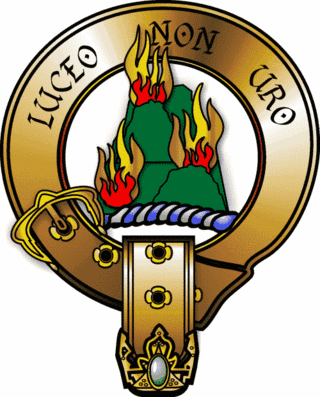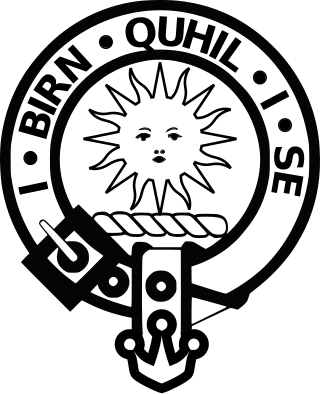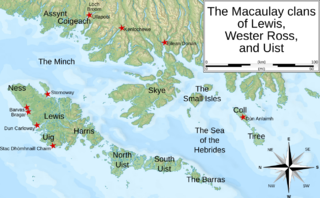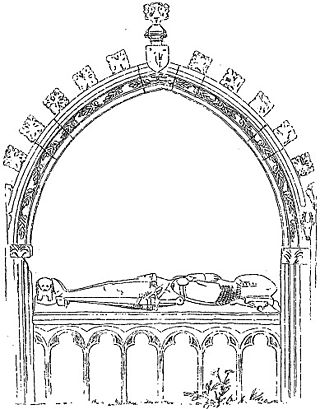
George Mackenzie, 2nd Earl of Seaforth (died 1651) was a Highland clan chief and Scottish nobleman, who played an equivocating role in Scotland in the Wars of the Three Kingdoms.

George Mackenzie, 2nd Earl of Seaforth (died 1651) was a Highland clan chief and Scottish nobleman, who played an equivocating role in Scotland in the Wars of the Three Kingdoms.
Mackenzie was the son of Kenneth Mackenzie, 1st Lord Mackenzie of Kintail (died 1611), and Isobel, the daughter of Sir Gilbert Ogilvie of Powrie. The Mackenzies were a clan from Ross-shire that had risen to prominence in the 15th century during the disintegration of the Lordship of the Isles.
On the death in 1633 of his elder half-brother Colin without male heirs, Mackenzie inherited his estates and the title of Earl of Seaforth. Prior to that point, he was known as George Mackenzie of Kildun.
As a result of the acquisitive proclivities of Seaforth's ancestors, his estates were very extensive.
In 1633 he was "served heir male to his brother … in the lands and barony of Ellandonnan, including the barony of Lochalsh, in which was included the barony of the lands and towns of Lochcarron, namely, the towns and lands of Auchnaschelloch, Coullin (Coulin), Edderancharron, Attadill, Ruychichan, Brecklach, Achachoull, Dalmartyne, with fishings in salt water and fresh, Dalcharlarie, Arrinachteg (Arineckaig), Achintie, Slumba (Slumbay), Doune, Stromcarronach (Strome Carronach), in the Earldom of Ross, of the old extent of £13 6s 8d, and also the towns of Kisserin, and lands of Strome, with fishings in salt and fresh water, and the towns and lands of Torridan with the pertinents of the Castle of Strome; Lochalsh, Lochcarron, and Kisserin, including the davach of Achvanie, the davach of Achnatrait (Achintraid?), the davach of Stromcastell, Ardnagald, Ardneskan, and Blaad, and the half davach of Sannachan (Sanachan), Rassoll (Rassal), Meikle Strome, and Rerag (Reraig), in the Earldom of Ross, together of the old extent of £8 13s 4d." He was served heir male to his father Kenneth, Lord Mackenzie of Kintail, in the lands and barony of Pluscardine, on 14 January 1620; and had charters of Balmungie and Avoch, on 18 July 1635; of Raasay, on 18 February 1637 and of Lochalsh, on 4 July 1642.
In the Bishops War, Seaforth, although personally attached to the king, was to be found on the side of the Covenant. He was appointed General of the Covenanters north of the Spey, but disbanded his army on Montrose's instructions following the Pacification of Berwick, which concluded on 18 June 1639. When Montrose joined the king's side, Seaforth too was suspected of lukewarmness for the Covenant. In 1640, he was temporarily imprisoned as a precautionary measure and in 1641, when the King arrived in Scotland, Seaforth was persuaded by the Earl of Traquair to enter into a bond with the Earls of Montrose, Wigtown, Atholl and Home against the Covenanters. However, he continued to equivocate, declining the king's offer of chief justice general of the Isles and taking up arms against Montrose after his victory at Aberdeen in September 1644.
Montrose (with an army of only 1,500) was preparing to attack his forces of about 5,000, when he was informed of Argyll's descent on Lochaber. Changing his route, Montrose won a famous victory at Inverlochy against Argyll on 2 February 1645. Following this victory, Seaforth met Montrose between Elgin and Forres and was held prisoner for several days, but was subsequently released, having apparently sworn allegiance to the King and having promised never again under any circumstances to take up arms against him. Notwithstanding this promise, he shortly afterwards joined Sir John Hurry the Covenanting general. On 9 May 1645 he took part in the Battle of Auldearn, which was fought between Hurry's army of Sutherlands, Mackenzies, Frasers, Roses and Brodies and Montrose's army of Gordons, Macdonalds, Macphersons, Mackintoshes and Irish. The result was another victory for Montrose, but the Mackenzies emerged largely unscathed. The Reverend John Macrae (d. 1704) gave a lengthy account of the battle (in the Ardintoul manuscript) which suggested that there had been deliberate collusion between Montrose, Hurry and Seaforth.
Be that as it may, Seaforth subsequently refused a commission from the Committee of Estates appointing him as their Lieutenant north of the Spey and was excommunicated by the General Assembly. He then joined Montrose publicly at the siege of Inverness in April 1646.
After Montrose's departure for Norway in September 1646, compulsory loans were levied against leading Royalists. Sixteen Mackenzies were ordered to provide loans totaling £28,666 (Scottish), but it appears that the authorities experienced great difficulties in enforcing their payment. The list provides an interesting snapshot of the perceived resources of some of the leading clan members of the time:
Seaforth's involvement in public affairs did not prevent him from pursuing (in the manner of his forebears) his own more personal concerns. In particular, he embarked on a remorseless campaign to wrest Assynt from the Macleods, laying siege to the castle of Donald Ban Mor Macleod on the Isle of Assynt in May 1646. His men were said (in a later complaint by the Macleods) to have carried away 3,000 cows, 2,000 horses and 7,000 sheep and goats, as well as burning the habitations of 180 families.
In 1648 Seaforth again raised a body of 4000 men in the Western Islands and Ross-shire, whom he led south, to aid the King's cause, but after joining in a few skirmishes under Lanark, they returned home to "cut their corn which was now ready for their sickles." During the whole of this period Seaforth's fidelity to the Royal cause was open to considerable suspicion, and when Charles I threw himself into the hands of the Scots at Newark, and ordered Montrose to disband his forces, Earl George, always trying to be on the winning side, came in to Middleton, and made terms with the Committee of Estates; but the Church, by whom he had previously been excommunicated, continued implacable, and would only agree to be satisfied by a public penance in sackcloth within the High Church of Edinburgh. The proud Earl consented, underwent this ignominious and degrading ceremonial, and his sentence of excommunication was then removed. Notwithstanding this public humiliation, after the death of Charles I, Seaforth, in a final act of tergiversation, went over to Holland in 1649, and joined Charles II, by whom he was made Principal Secretary of State for Scotland, the duties of which, however, he never had the opportunity of performing.
When Seaforth received the news of the disastrous defeat of the king's forces at Worcester, he fell into a profound melancholy and died in August 1651, in Schiedam, Holland.
Early in life, he had married Barbara, daughter of Arthur, Lord Forbes, and had by her at least eight children, including his heir and successor, Kenneth. Of his three daughters, Jean married first John, Earl of Mar, and secondly Andrew Fraser, 3rd Lord Fraser; Margaret married Sir William Sinclair of Mey; and Barbara married Sir John Urquhart of Cromarty.

Clan Mackenzie is a Scottish clan, traditionally associated with Kintail and lands in Ross-shire in the Scottish Highlands. Traditional genealogies trace the ancestors of the Mackenzie chiefs to the 12th century. However, the earliest Mackenzie chief recorded by contemporary evidence is Alexander Mackenzie of Kintail who died some time after 1471. Traditionally, during the Wars of Scottish Independence, the Mackenzies supported Robert the Bruce, but feuded with the Earls of Ross in the latter part of the 14th century. During the 15th and 16th-centuries the Mackenzies feuded with the neighboring clans of Munro and MacDonald. In the 17th century the Mackenzie chief was made Earl of Seaforth in the peerage of Scotland. During the Scottish Civil War of the 17th century the Mackenzies largely supported the Royalists. During the Jacobite rising of 1715 the chief and clan of Mackenzie supported the Jacobite cause. However, during the Jacobite rising of 1745 the clan was divided with the chief, Kenneth Mackenzie, Lord Fortrose, supporting the British-Hanoverian Government and his relative, George Mackenzie, 3rd Earl of Cromartie, supporting the Jacobites.

Earl of Seaforth was a title in the Peerage of Scotland and the Peerage of Ireland, derived from Loch Seaforth on the coast of Lewis. It was held by the family of Mackenzie from 1623 to 1716, and again from 1771 to 1781.
The Battle of Auldearn was an engagement of the Wars of the Three Kingdoms. It took place on 9 May 1645, in and around the village of Auldearn in Nairnshire. It resulted in a victory for the royalists, led by the Marquess of Montrose and Alasdair MacColla, over Sir John Urry and an army raised by the Covenanter-dominated Scottish government.

Clan MacDonell of Glengarry, also known as Clan Ranald of Knoydart & Glengarry is a Scottish clan and is a branch of the larger Clan Donald. The clan takes its name from River Garry where the river Garry runs eastwards through Loch Garry to join the Great Glen about 16 miles (25 km) north of Fort William, Highland. The progenitor of the MacDonells of Glengarry is Reginald, 4th great-grandson of the warrior Somerled. The clan chief is traditionally designated as the "Son of Alexander's son".

Dingwall or Dingwell is a Scottish surname but is of Viking origin. One of the most prominent families by the name of Dingwall in Scotland were the Dingwalls of Kildun who were vassals of the Earl of Ross and also septs of the Clan Munro, a Scottish clan of the Scottish Highlands.

Castle Chanonry of Ross, also known as Seaforth Castle, was located in the town of Fortrose, to the north-east of Inverness, on the peninsula known as the Black Isle, Highland, Scotland. Nothing now remains of the castle. The castle was also known as Canonry or Chanonrie of Ross, the former county.

Strome Castle is a ruined castle on the shore of Loch Carron in Stromemore, 3.5 miles south-west of the village of Lochcarron, on the headland between Loch Carron and Loch Kishorn, on the west coast of the Scottish Highlands.

Clan MacLeod of The Lewes, commonly known as Clan MacLeod of Lewis, is a Highland Scottish clan, which at its height held extensive lands in the Western Isles and west coast of Scotland. From the 14th century up until the beginning of the 17th century there were two branches of Macleods: the MacLeods of Dunvegan and Harris ; and the Macleods of the Isle of Lewis. In Gaelic the Macleods of Lewis were known as Sìol Thorcaill, and the MacLeods of Dunvegan and Harris were known as Sìol Thormoid.

The Macaulay family of Uig in Lewis, known in Scottish Gaelic as Clann mhic Amhlaigh, were a small family located around Uig on the Isle of Lewis in the Outer Hebrides of Scotland. There is no connection between the Macaulays of Lewis and Clan MacAulay which was centred in the Loch Lomond area, bordering the Scottish Highlands and Scottish Lowlands. The Macaulays of Lewis are generally said to be of Norse origin because of the etymology of their surname and also because of the islands' Viking Age past. However, a recent analysis of the Y-DNA of men with Scottish surnames has shown that a large number of Hebridean Macaulays are of Irish origin. In the 17th century, however, tradition gave the Macaulays an Irish origin. By the end of the 16th century the dominant clan on Lewis was Clan Macleod of The Lewes. Other notable Lewis clans were the somewhat smaller Morrisons of Ness and the even less numerous Macaulays of Uig. The Macaulays were centred in the area surrounding Uig on the western coast of Lewis, and had a deadly, long-standing feud with the Morrisons, whose lands were located on the northern coast around Ness. Today the Lewis surname Macaulay is considered to be a sept name of the Macleods of Lewis. There are two other nearby clans of Macaulays who may, or may not, be connected to the Lewis clan—the Wester Ross Macaulays, and the Uist MacAulays.
Kenneth Mackenzie, the first Lord Mackenzie of Kintail, was a Highland clan chief who secured for himself and his heirs the entirety of the Isle of Lewis in the Outer Hebrides and successfully pursued a bloody feud with the Macdonells of Glengarry.
Colin Mackenzie, 1st Earl of Seaforth (1596/97–1633), was a Highland clan chief and Scottish nobleman, possessed of vast estates and wealth.
Alexander Mackenzie, known as "Ionraic", traditionally counted as 6th of Kintail, was the first chief of the Clan Mackenzie of whom indisputable contemporary documentary evidence survives. During his long life, he greatly expanded his clan's territories and influence.
Hector Roy Mackenzie of Gairloch was a Scottish clan chieftain of the Clan Mackenzie, who acquired vast estates in and around Gairloch, Wester Ross as a result of his services to the Scottish crown and challenged his nephew for the chiefship of the clan.
Colin Mackenzie of Kintail, nicknamed "Cam", was a Highland chief of the Scottish clan Mackenzie who greatly increased his ancestral estates through royal favour and a career of vigorous self-aggrandisement.
The chiefs of the Scottish highland Clan Mackenzie were historically known as the Mackenzies of Kintail. By tradition the Mackenzie chiefs descend from Kenneth Mackenzie, 1st of Kintail however their earliest ancestor proven by contemporary evidence is Alexander Mackenzie, 6th of Kintail. The chiefly line became the Earls of Seaforth during the 17th century but this title was later forfeited in the 18th century due to support of the Jacobite rising of 1715. The current official chief of the Clan Mackenzie is John Ruaridh Grant Mackenzie, 5th Earl of Cromartie.

Kenneth Mackenzie, traditionally reckoned 7th of Kintail and nicknamed Coinneach a'bhlair, was a Highland chief, being head of the Clan Mackenzie.
Roderick Macleod, also known as Old Rory, was the chief of Clan Macleod of Lewes in the later half of the 16th century.

Lochalsh is a district of mainland Scotland that is currently part of the Highland council area. The Lochalsh district covers all of the mainland either side of Loch Alsh - and of Loch Duich - between Loch Carron and Loch Hourn, ie. from Stromeferry in the north on Loch Carron down to Corran on Loch Hourn and as (south-)west as Kintail. It was sometimes more narrowly defined as just being the hilly peninsula that lies between Loch Carron and Loch Alsh. The main settlement is Kyle of Lochalsh, located at the entrance to Loch Alsh, opposite the village of Kyleakin on the adjacent island of Skye. A ferry used to connect the two settlements but was replaced by the Skye Bridge in 1995.
The MacLeods of Raasay are a minor Scottish noble family and branch of Clan MacLeod of Lewis. At their height they held extensive lands on the Isle of Raasay. In Gaelic the MacLeods of Lewis were known as Sìol Thorcaill. The Chiefship of Clan MacLeod of Lewis passed to the Raasay branch in the 20th century.
Thomas Mackenzie of Pluscarden, also known as of Pluscardine was a Scottish soldier and member of parliament of the 17th century. He was a member of the Clan Mackenzie, a Scottish clan of the Scottish Highlands.